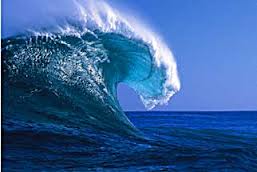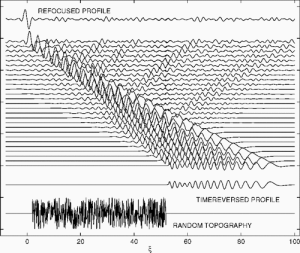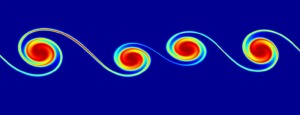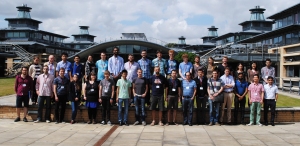 On the afternoon of 6 August, the programme held a forward looking session, chaired by Tom Bridges, Mark Groves and Paul Milewski. The session started with a backward looking session, reviewing and discussing the topics covered during the programme: water-wave stability (periodic waves in finite depth with surface tension, vorticity, and very shallow water; the Benjamin-Feir instability from many points of view; modulation instability for non-local operators; transverse instability of gen solitary waves; cascades induced by BF instability); large amplitude waves (experimentally generated, singularities of highest steady waves, splash singularities, role of vorticity, self-similarity); numerics (HOPS methods, high-performance numerics for standing waves, BEM & spectral methods, FEM & Galerkin methods, symplectic time integration, and CFD); 3D waves (lump solitary waves, 3D localized solitary waves, multi-periodic patterns); analysis and validity (Birkhoff normal form, IVP, DNO, small divisors, the unified transform, inverse problems, comparison of NLS breathers to Euler breathers). Other topics of discussion included jet currents, statistical approaches, tsunamis, bottom topography, droplet dynamics, wave-energy harvesting, wind-wave interaction, new model equations, and particle paths in waves. A lively discussion was held on the relative merits of the various results and approaches. It was agreed that the programme, and the present state of the art, barely scratched the surface of the wide range of problems of interest in the theory of water waves. Topics and problems flagged up for future work include: post-instability dynamics; the importance of well-posedness particularly for truncated models; the need for global well-posedness to validate nonlinear stability of solitary waves; what models and equations are appropriate for breaking, splashing, entrainment, and bubbles; a hierarchy of models and formulations; a encyclopedia of known results (analytical, numerical, rigorous) on all steady and time-periodic waves and their stability; new numerical methods and comparison between different methods; any theoretical development on (a) wind-wave interaction, (b) three dimensional waves of every shape and form, (c) extreme waves, and (d) any type of breaking waves.
On the afternoon of 6 August, the programme held a forward looking session, chaired by Tom Bridges, Mark Groves and Paul Milewski. The session started with a backward looking session, reviewing and discussing the topics covered during the programme: water-wave stability (periodic waves in finite depth with surface tension, vorticity, and very shallow water; the Benjamin-Feir instability from many points of view; modulation instability for non-local operators; transverse instability of gen solitary waves; cascades induced by BF instability); large amplitude waves (experimentally generated, singularities of highest steady waves, splash singularities, role of vorticity, self-similarity); numerics (HOPS methods, high-performance numerics for standing waves, BEM & spectral methods, FEM & Galerkin methods, symplectic time integration, and CFD); 3D waves (lump solitary waves, 3D localized solitary waves, multi-periodic patterns); analysis and validity (Birkhoff normal form, IVP, DNO, small divisors, the unified transform, inverse problems, comparison of NLS breathers to Euler breathers). Other topics of discussion included jet currents, statistical approaches, tsunamis, bottom topography, droplet dynamics, wave-energy harvesting, wind-wave interaction, new model equations, and particle paths in waves. A lively discussion was held on the relative merits of the various results and approaches. It was agreed that the programme, and the present state of the art, barely scratched the surface of the wide range of problems of interest in the theory of water waves. Topics and problems flagged up for future work include: post-instability dynamics; the importance of well-posedness particularly for truncated models; the need for global well-posedness to validate nonlinear stability of solitary waves; what models and equations are appropriate for breaking, splashing, entrainment, and bubbles; a hierarchy of models and formulations; a encyclopedia of known results (analytical, numerical, rigorous) on all steady and time-periodic waves and their stability; new numerical methods and comparison between different methods; any theoretical development on (a) wind-wave interaction, (b) three dimensional waves of every shape and form, (c) extreme waves, and (d) any type of breaking waves.
-
Recent Posts
Recent Comments
Archives
Categories
Meta









